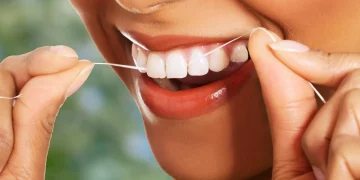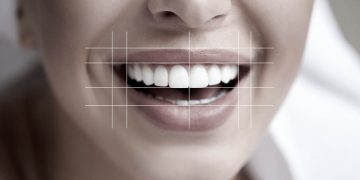Introduction
We all know that brushing our teeth is an essential habit for maintaining oral health, but many of us tend to overlook the role of dental floss. While most people believe that brushing is enough, the truth is that brushing alone cannot thoroughly clean the spaces between your teeth. These tight areas are prime spots for food particles and plaque to accumulate, and unfortunately, brushing can’t reach them effectively. This is where dental floss comes in as an indispensable tool for oral hygiene. But how important is dental floss? Does it really improve your oral health? In this article, we will explore the role of dental floss, its benefits, and why it should be a crucial part of your daily oral care routine.
What Is Dental Floss?
Dental floss is a thin, flexible strand, usually made of nylon or Teflon, designed to clean the tight spaces between your teeth where a toothbrush can’t reach. It can be waxed or unwaxed, and some flosses are even infused with flavors or fluoride to provide additional benefits.
Flossing involves gently inserting the floss between your teeth and moving it up and down to remove food particles and plaque that accumulate in these spaces. When done correctly, it complements brushing by providing a more thorough clean and significantly reducing the risk of dental issues like cavities and gum disease.
Why Is Flossing Important?
1. Removes Plaque from Hard-to-Reach Areas
Plaque is a sticky film of bacteria that forms on your teeth throughout the day. While brushing helps remove plaque from the surface of your teeth, it cannot reach the spaces between them. Plaque left between the teeth can lead to tooth decay, gum disease, and bad breath. Flossing helps remove plaque from these areas, reducing the overall bacterial buildup in your mouth and preventing these issues.
2. Prevents Cavities Between Teeth
Tooth decay often starts between the teeth, where food particles and plaque accumulate. These areas are difficult to clean with a toothbrush alone, especially in tight spaces where the bristles cannot reach. By flossing regularly, you remove the plaque and food debris that can otherwise lead to cavities. Studies have shown that people who floss daily are significantly less likely to develop cavities between their teeth compared to those who don’t.
3. Reduces the Risk of Gum Disease
Gum disease, which begins as gingivitis (inflammation of the gums), is one of the most common oral health problems. Gingivitis is typically caused by the buildup of plaque along the gumline, which can lead to swollen, bleeding gums. If left untreated, gingivitis can develop into periodontitis, a more severe form of gum disease that can result in tooth loss. Flossing helps remove plaque from the gumline and between the teeth, reducing the risk of gum disease and promoting healthier gums.
4. Prevents Bad Breath
Bad breath, or halitosis, is often caused by the buildup of bacteria in the mouth. These bacteria feed on food particles and plaque that linger between your teeth, releasing sulfur compounds that contribute to unpleasant odors. Flossing helps remove food particles and bacteria from between your teeth, preventing bad breath and leaving your mouth feeling fresher.
5. Promotes Overall Health
Maintaining good oral hygiene isn’t just about having a bright smile — it also impacts your overall health. Research has shown that gum disease is linked to several systemic health conditions, including heart disease, diabetes, and stroke. By flossing regularly and maintaining healthy gums, you’re not only preventing dental issues but also lowering your risk for these serious health conditions.
How to Floss Correctly
Using dental floss correctly is essential to ensure that you’re getting the full benefits. Here’s how to floss properly:
1. Use the Right Amount of Floss
Cut about 18-24 inches (45-60 cm) of dental floss. This amount is sufficient to reach all areas of your mouth without using too much. Wind most of the floss around your middle fingers, leaving a few inches to work with.
2. Gently Guide the Floss Between Your Teeth
Carefully slide the floss between your teeth using a gentle back-and-forth motion. Be cautious not to snap or force the floss, as this can injure your gums.
3. Form a C-Shape Around Each Tooth
Once the floss is between your teeth, curve it into a C-shape around one tooth. Gently move the floss up and down along the sides of the tooth, cleaning both the front and back surfaces. Repeat this process for each tooth, making sure to clean both sides of every tooth.
4. Don’t Forget the Back Teeth
The back teeth, especially the molars, are often harder to reach. Be sure to floss these areas thoroughly by gently sliding the floss behind the last tooth in each quadrant of your mouth.
5. Rinse Your Mouth After Flossing
After you’ve finished flossing, rinse your mouth with water or mouthwash to help remove any leftover food particles and bacteria.

Common Flossing Mistakes to Avoid
While flossing is straightforward, many people make mistakes that reduce its effectiveness. Here are a few common flossing errors to watch out for:
1. Flossing Too Roughly
Flossing should be gentle. If you snap or saw the floss between your teeth, you could injure your gums, leading to irritation or bleeding. Always use a gentle back-and-forth motion to guide the floss between your teeth.
2. Not Using Enough Floss
Using a short piece of floss doesn’t provide enough material to clean between your teeth effectively. Using around 18-24 inches of floss allows you to use a fresh section of floss for each tooth, reducing the transfer of bacteria from one part of your mouth to another.
3. Skipping Certain Teeth
Some people skip flossing the back teeth because they’re harder to reach. However, the back teeth are often the most vulnerable to plaque buildup and decay, so it’s essential to floss these areas thoroughly as well.
4. Not Flossing Regularly
Flossing once in a while is not enough to make a significant impact on your oral health. To experience the full benefits of flossing, you should floss at least once a day. Many people find that flossing before bed is most effective because it removes food particles and bacteria accumulated throughout the day.
When Should You Floss?
The best time to floss is typically before brushing your teeth, as flossing removes plaque and debris from between the teeth, making it easier for your toothbrush to clean the surfaces of your teeth. However, if you prefer to floss after brushing, that’s fine too — the key is consistency.
Alternatives to Traditional Floss
While traditional flossing is effective, some people find it difficult to use. For those who struggle with traditional dental floss, there are alternative options available:
- Floss Picks: These are small, disposable tools that hold a piece of floss between two prongs, making it easier to use without wrapping the floss around your fingers.
- Water Flossers: Also known as oral irrigators, water flossers use a stream of water to clean between your teeth and along the gumline. They can be especially helpful for people with braces or sensitive gums.
- Interdental Brushes: These tiny, brush-like tools can be used to clean the spaces between teeth, particularly in areas where floss may be difficult to maneuver.
While these alternatives can be effective, traditional floss remains the gold standard for cleaning between teeth.
Conclusion
Dental floss is an essential tool for maintaining optimal oral health. It removes plaque and food particles from between your teeth, where a toothbrush can’t reach. Regular flossing helps prevent cavities, gum disease, and bad breath, while also promoting overall health. By incorporating flossing into your daily oral care routine, you’ll be taking an important step toward a cleaner, healthier mouth.
Remember, the key to flossing is consistency. Floss at least once a day, be gentle, and follow the proper technique to maximize the benefits for your oral hygiene. Your gums and teeth will thank you for it!













































Discussion about this post